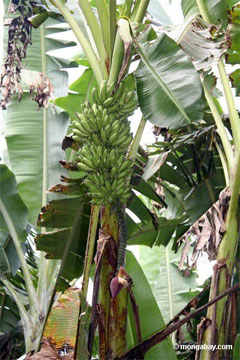Concern over declining banana biodiversity
the United Nations Food and Agriculture Organization
May 7, 2006
Shrinking numbers of wild bananas in India, the world’s premier producer, are causing concern at the United Nations Food and Agriculture Organization. FAO is committed to preserving agricultural biodiversity.
The first session of the Governing Body of the International Treaty on Plant Genetic Resources for Food and Agriculture, which came into force in 2004 under the auspices of FAO, will take place from 12-16 June in Madrid.
India is the world’s biggest banana grower, with an annual production of 16.8 million tonnes, or over 20 percent of total world output of 72.6 million tonnes in 2005.
But overexploitation and the loss of forests as a result of encroachment and logging, slash-and-burn cultivation and urbanization are causing a rapid loss of wild banana species that have existed in India for thousands of years. Among them are the ancestors of the Cavendish variety, the large, pulpy dessert banana which currently accounts for virtually all of world trade, amounting to nearly 20 million tonnes a year.
Cooking bananas and plantains — eaten fried, boiled, baked or chipped — are the staple food of 400 million people in the developing world, while bananas are also used to make fibres and beer. In India, they play an important role in traditional medicine.
Bananas are the world’s most exported fruit and the fourth most important food commodity on earth — after rice, wheat and maize — in terms of production value.
Preserving biodiversity
“The Indian subcontinent has made an enormous contribution to the global genetic base of bananas,” says FAO Agricultural Officer NeBambi Lutaladio. “But due to ecosystem destruction, it is probable that many valuable gene sources have now been lost.
“That could cause serious problems because bananas, particularly commercial varieties, have a narrow genetic pool and are highly vulnerable to pests and diseases.”
In the 1950s, the then dominant commercial banana, Gros Michel, was destroyed by Panama disease. Cavendish, which resisted the disease, was introduced then.
 How Chiquita Bananas Changed Its Environmental Legacy The notorious United Fruit Company, which became Chiquita Brands International, dominated Latin American agriculture for nearly a century, epitomizing the exploitation of local people and resources implied by the term “banana republic.” Beginning in the 1990s, an astonishing transformation began at Chiquita, a transformation not compelled by any government or policing agency, but driven by an unprecedented voluntary shift in focus and by a desire to protect its brand. In partnership with the nonprofit Rainforest Alliance, Chiquita set out to improve conditions for its workers, to minimize the environmental impact of its farms, and to conserve the rainforest surrounding its plantations. But could a longtime offender really work cooperatively with a group of activists? Could voluntary action really make a difference? And would progress be real and lasting or cosmetic and fleeting? |
|
Mr Lutaladio pointed out, however, that small-scale farmers around the world grow a wide range of bananas that are not threatened by diseases currently threatening commercial bananas.
Exploration
India’s lost bananas include a variety which conferred genetic resistance to the dreaded black Sigatoka fungus disease that devastated plantations in the Amazon and elsewhere. Only one clone of the species, whose scientific name is Musa Acuminata spp Burmannicoides, remains at the Indian Botanic Gardens in Calcutta.
FAO is urging a systematic exploration of the wild bananas’ remaining forest habitat, which lies in some of India’s remotest regions and in the jungles of Southeast Asia, to assess the damage and catalogue the number and types of surviving wild species. It is also calling for conservation efforts focusing on better land management by local populations, and research on expanding the use of wild bananas in breeding programmes.
Historically, it was Alexander the Great who put bananas on the map in 327 BC when, during his invasion of India, he reported eating and enjoying them.
The name banana derives from the Arab banan, or finger. Arab traders were responsible for introducing the plant to Africa, while it was the Portuguese who took bananas to the Caribbean and Latin America.
This article is a modified news release from the United Nations Food and Agriculture Organization.